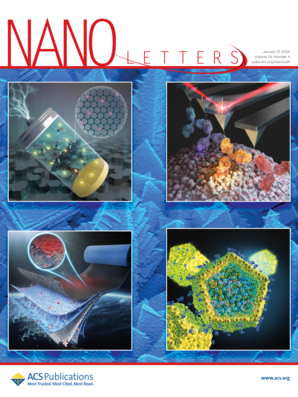Self-Aligned Multilayered Nitrogen Vacancy Diamond Nanoparticles for High Spatial Resolution Magnetometry of Microelectronic Currents
IF 9.6
1区 材料科学
Q1 CHEMISTRY, MULTIDISCIPLINARY
引用次数: 0
Abstract
Nitrogen vacancy diamond nanoparticles (NVNPs) are increasingly integrated with methods for optical detection of magnetic resonance (ODMR), providing new opportunities spanning the visualization of magnetic fields in microelectronic circuits, environmental sensing, and biology. However, only a small number of studies utilize aggregates of NVNPs for surface-wide magnetometry, with the fact that spin orientations in aggregate NVNPs are inherently misaligned, precluding proper magnetic field detection, compared with expensive monocrystalline diamonds. A post-processing method for layering NVNPs with aligned center orientations can potentially facilitate superior NV magnetometry by allowing sensitive detection with a simplified probe preparation. We present novel technology for creating densely stacked NVNP monolayers with inherent interlayer alignment for sensitive measurement of local field perturbations in microelectronic traces. We establish spatial characteristics of deposited aggregates and demonstrate their ability to capture dipoles from conducting microwires via ODMR. Our approach forms a novel accessible protocol that can be used for broad applications in micromagnetometry.

用于微电子电流高空间分辨率磁强计的自对准多层氮空位金刚石纳米颗粒
氮空位金刚石纳米颗粒(NVNPs)越来越多地与磁共振光学检测(ODMR)方法相结合,为微电子电路、环境传感和生物学领域的磁场可视化提供了新的机会。然而,与昂贵的单晶金刚石相比,只有少数研究利用NVNPs聚集体进行表面磁强计,事实上,NVNPs聚集体的自旋方向固有地错位,妨碍了适当的磁场检测。一种将中心取向对齐的NVNPs分层的后处理方法可以通过简化探针制备实现灵敏的检测,从而潜在地促进优越的NV磁强计。我们提出了一种新技术,用于创建具有固有层间排列的密集堆叠NVNP单层,用于微电子迹线中局部场扰动的敏感测量。我们建立了沉积聚集体的空间特征,并证明了它们通过ODMR从导电微线捕获偶极子的能力。我们的方法形成了一种新的可访问协议,可用于微磁计的广泛应用。
本文章由计算机程序翻译,如有差异,请以英文原文为准。
求助全文
约1分钟内获得全文
求助全文
来源期刊

Nano Letters
工程技术-材料科学:综合
CiteScore
16.80
自引率
2.80%
发文量
1182
审稿时长
1.4 months
期刊介绍:
Nano Letters serves as a dynamic platform for promptly disseminating original results in fundamental, applied, and emerging research across all facets of nanoscience and nanotechnology. A pivotal criterion for inclusion within Nano Letters is the convergence of at least two different areas or disciplines, ensuring a rich interdisciplinary scope. The journal is dedicated to fostering exploration in diverse areas, including:
- Experimental and theoretical findings on physical, chemical, and biological phenomena at the nanoscale
- Synthesis, characterization, and processing of organic, inorganic, polymer, and hybrid nanomaterials through physical, chemical, and biological methodologies
- Modeling and simulation of synthetic, assembly, and interaction processes
- Realization of integrated nanostructures and nano-engineered devices exhibiting advanced performance
- Applications of nanoscale materials in living and environmental systems
Nano Letters is committed to advancing and showcasing groundbreaking research that intersects various domains, fostering innovation and collaboration in the ever-evolving field of nanoscience and nanotechnology.
 求助内容:
求助内容: 应助结果提醒方式:
应助结果提醒方式:


